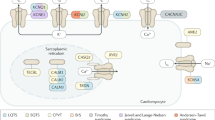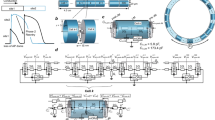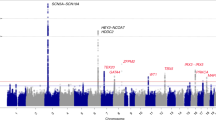Abstract
Brugada syndrome is a clinical entity characterized by ST-segment elevation in the right precordial leads (V1–V3) and an episode of ventricular fibrillation in the absence of structural heart disease. Data regarding genotype–phenotype relationships are limited, since SCN5A, the gene encoding the α subunit of the sodium channel, is as yet the only gene linked to Brugada syndrome. Studies of SCN5A mutations responsible for the Brugada phenotype have shown the presence of functional defects in the sodium-channel current. Experimental studies employing arterially perfused right-ventricular wedge preparations have elucidated cellular mechanisms for this phenotype. Data indicate that an accentuated action-potential notch, mediated by a prominent transient outward current and loss of the action-potential dome in the epicardium (but not in the endocardium) of the right ventricle give rise to a transmural voltage gradient, resulting in ST-segment elevation and the induction of ventricular fibrillation. On the basis of cellular mechanisms, it might be possible to normalize the Brugada phenotype by use of therapeutic agents or interventions that decrease net outward currents by decreasing the transient outward current or outward potassium currents, or increasing the L-type inward calcium current or fast sodium current. Interventions that increase net outward currents through raising the transient outward current or outward potassium currents or decreasing the L-type inward calcium current or fast sodium current might aggravate or unmask the Brugada phenotype, resulting in an acquired form of this syndrome. In this review, we discuss future challenges relating to risk stratification, genetic heterogeneity, sex and ethnic differences in Brugada syndrome.
This is a preview of subscription content, access via your institution
Access options
Subscribe to this journal
Receive 12 print issues and online access
$209.00 per year
only $17.42 per issue
Buy this article
- Purchase on Springer Link
- Instant access to full article PDF
Prices may be subject to local taxes which are calculated during checkout


Similar content being viewed by others
References
Brugada P and Brugada J (1992) Right bundle branch block, persistent ST segment elevation and sudden cardiac death: a distinct clinical and electrocardiographic syndrome: a multicenter report. J Am Coll Cardiol 20: 1391–1396
Brugada J et al. (1998) Right bundle-branch block and ST-segment elevation in leads V1 through V3. A marker for sudden death in patients without demonstrable structural heart disease. Circulation 97: 457–460
Gussak I et al. (1999) The Brugada syndrome: clinical, electrophysiological and genetic aspects. J Am Coll Cardiol 33: 5–15
Alings M and Wilde A (1999) “Brugada” syndrome: Clinical data and suggested pathophysiological mechanism. Circulation 99: 666–673
Antzelevitch C et al. (1999) Clinical Approaches to Tachyarrhythmias: Vol. 10 The Brugada Syndrome, p1–99 (ed Camm AJ) New York: Futura
Antzelevitch C et al. (2002) Brugada syndrome. A decade of progress. Circ Res 91: 1114–1118
Priori SG et al. (2002) Natural history of Brugada syndrome: insights for risk stratification and management. Circulation 105: 1342–1347
Wilde AA et al. (2002) Proposed diagnostic criteria for the Brugada syndrome: consensus report. Circulation 106: 2514–2519
Brugada J et al. (2002) Long-term follow-up of individuals with the electrocardiographic pattern of right bundle-branch block and ST-segment elevation in precordial leads V1 to V3. Circulation 105: 73–78
Brugada J et al. (2003) Determinants of sudden cardiac death in individuals with the electrocardiographic pattern of Brugada syndrome and no previous cardiac arrest. Circulation 108: 3092–3096
Antzelevitch C et al. (2005) Brugada Syndrome. Report of the Second Consensus Conference. Endorsed by the Heart Rhythm Society and the European Heart Rhythm Association. Circulation 111: 659–670
Nademanee K et al. (1997) Arrhythmogenic marker for the sudden unexplained death syndrome in Thai men. Circulation 96: 2595–2600
Miyazaki T et al. (1996) Autonomic and antiarrhythmic drug modulation of ST-segment elevation in patients with Brugada syndrome. J Am Coll Cardiol 27: 1061–1070
Vatta M et al. (2002) Genetic and biophysical basis of sudden unexplained nocturnal death syndrome (SUNDS), a disease allelic to Brugada syndrome. Hum Mol Genet 11: 337–345
Matsuo K et al. (1998) Dynamic changes of 12-lead electrocardiograms in a patient with Brugada syndrome. J Cardiovasc Electrophysiol 9: 508–512
Atarashi H et al. (2001) Three-year follow-up of patients with right bundle branch block and ST segment elevation in the right precordial leads: Japanese Registry of Brugada Syndrome. Idiopathic Ventricular Fibrillation Investigators. J Am Coll Cardiol 37: 1916–1920
Brugada R et al. (2000) Sodium channel blockers identify risk for sudden death in patients with ST-segment elevation and right bundle branch block but structurally normal hearts. Circulation 101: 510–515
Shimizu W et al. (2000) Effect of sodium channel blockers on ST segment, QRS duration, and corrected QT interval in patients with Brugada syndrome. J Cardiovasc Electrophysiol 11: 1320–1329
Shimizu W et al. (2000) Body surface distribution and response to drugs of ST segment elevation in the Brugada syndrome: Clinical implication of 87-leads body surface potential mapping and its application to 12-leads electrocardiograms. J Cardiovasc Electrophysiol 11: 396–404
Kanda M et al. (2002) Electrophysiologic characteristics and implication of induced ventricular fibrillation in symptomatic patients with Brugada syndrome. J Am Coll Cardiol 39: 1799–1805
Eckardt L et al. (2005) Long-term prognosis of individuals with right precordial ST-segment-elevation Brugada syndrome. Circulation 111: 257–263
Chen Q et al. (1998) Genetic basis and molecular mechanisms for idiopathic ventricular fibrillation. Nature 392: 293–296
Weiss R et al. (2002) Clinical and molecular heterogeneity in the Brugada syndrome. A novel gene locus on chromosome 3. Circulation 105: 707–713
Smits JP et al. (2002) Genotype-phenotype relationship in Brugada syndrome: electrocardiographic features differentiate SCN5A-related patients from non-SCN5A-related patients. J Am Coll Cardiol 40: 350–356
Tan HL et al. (2003) Genetic control of sodium channel function. Cardiovasc Res 57: 961–973
Bezzina C et al. (1999) A single Na+ channel mutation causing both long-QT and Brugada syndromes. Circ Res 85: 1206–1213
Kyndt F et al. (2001) Novel SCN5A mutation leading either to isolated cardiac conduction defect or Brugada syndrome in a large French family. Circulation 104: 3081–3086
Viswanathan PC et al. (2001) Gating-dependent mechanisms for flecainide action in SCN5A-linked arrhythmia syndromes. Circulation 104: 1200–1205
Baroudi G et al. (2002) Expression and intracellular localization of an SCN5A double mutant R1232W/T1620M implicated in Brugada syndrome. Circ Res 90: E11–E16
Viswanathan PC et al. (2003) A common SCN5A polymorphism modulates the biophysical effects of an SCN5A mutation. J Clin Invest 111: 341–346
Makielski JC et al. (2003) A ubiquitous splice variant and a common polymorphism affect heterologous expression of recombinant human SCN5A heart sodium channels. Circ Res 93: 821–828
Wang DW et al. (2002) Clinical, genetic, and biophysical characterization of SCN5A mutations associated with atrioventricular conduction block. Circulation 105: 341–346
Priori SG et al. (2000) The elusive link between LQT3 and Brugada syndrome: the role of flecainide challenge. Circulation 102: 945–947
Yan GX and Antzelevitch C (1996) Cellular basis for the electrocardiographic J wave. Circulation 93: 372–379
Yan GX and Antzelevitch C (1999) Cellular basis for the Brugada syndrome and other mechanisms of arrhythmogenesis associated with ST segment elevation. Circulation 100: 1660–1666
Litovsky SH and Antzelevitch C (1988) Transient outward current prominent in canine ventricular epicardium but not endocardium. Circ Res 62: 116–126
Wettwer E et al. (1994) Transient outward current in human ventricular myocytes of subepicardial and subendocardial origin. Circ Res 75: 473–482
Krishnan SC and Antzelevitch C (1993) Flecainide-induced arrhythmia in canine ventricular epicardium. Phase 2 reentry? Circulation 87: 562–572
Aiba T et al. (2004) Steep repolarization gradient is required for development of phase 2 reentry and subsequent ventricular tachyarrhythmias in a model of the Brugada syndrome: High-resolution optical mapping study. Circulation 110: III [Abstract #318]
Alings M et al. (2001) Quinidine induced electrocardiographic normalization in two patients with Brugada syndrome. PACE 24: 1420–1422
Hermida JS et al. (2004) Hydroquinidine therapy in Brugada syndrome. J Am Coll Cardiol 43: 1853–1860
Belhassen B et al. (2004) Efficacy of quinidine in high-risk patients with Brugada syndrome. Circulation 110: 1731–1737
Shimizu W and Kamakura S (2001) Catecholamines in children with congenital long QT syndrome and Brugada syndrome. J Electrocardiol 34: 173–175
Tsuchiya T et al. (2002) Prevention of ventricular fibrillation by cilostazol, an oral phosphodiesterase inhibitor, in a patient with Brugada syndrome. J Cardiovasc Electrophysiol 13: 698–701
Suzuki H et al. (2000) Infant case with a malignant form of Brugada syndrome. J Cardiovasc Electrophysiol 11: 1277–1280
Morita H et al. (2003) Ventricular arrhythmia induced by sodium channel blocker in patients with Brugada syndrome. J Am Coll Cardiol 42: 1624–1631
Shimizu W (2004) Acquired Forms of Brugada Syndrome. In The Brugada Syndrome: From bench to bedside p166–177 (ed Antzelevitch C) UK: Blackwell, Futura
Goldgran-Toledano D et al. (2002) Overdose of cyclic antidepressants and the Brugada syndrome. N Engl J Med 346: 1591–1592
Myers GB (1950) Other QRS-T patterns that may be mistaken for myocardial infarction IV: alterations in blood potassium; myocardial ischemia; subepicardial myocarditis; distortion associated with arrhythmias. Circulation 2: 75–93
Kataoka H (2000) Electrocardiographic patterns of the Brugada syndrome in right ventricular infarction/ischemia. Am J Cardiol 86: 1056
Nogami A et al. (2003) Enhancement of J-ST-segment elevation by the glucose and insulin test in Brugada syndrome. PACE 26: 332–337
Antzelevitch C and Brugada R (2002) Fever and Brugada syndrome. PACE 25: 1537–1539
Noda T et al. (2003) Prominent J wave and ST segment elevation: serial electrocardiographic changes in accidental hypothermia. J Cardiovasc Electrophysiol 14: 223
Shimizu W (2004) Gender difference and drug challenge in Brugada syndrome. J Cardiovasc Electrophysiol 15: 70–71
Di Diego JM et al. (2002) Ionic and cellular basis for the predominance of the Brugada syndrome phenotype in males. Circulation 106: 2004–2011
Matsuo K et al. (2003) Disappearance of the Brugada-type electrocardiogram after surgical castration: a role for testosterone and an explanation for the male preponderance. PACE 26: 1551–1553
Shimizu W et al. (2004) Role of testosterone on male predominance in Brugada syndrome [Abstract #500]. Circulation 110 III
Splawski I et al. (2002) Variant of SCN5A sodium channel implicated in risk of cardiac arrhythmia. Science 297: 1333–1336
Pfeufer A et al. (2004) A common haplotype in the 5' region of the SCN5A gene is strongly associated with ventricular conduction impairment [Abstract #229]. Circulation 110: III
Acknowledgements
We thank Ichiro Hidaka, Department of Cardiovascular Dynamics, Research Institute, National Cardiovascular Center, Japan, for expert technical assistance. W Shimizu was supported by the Hoansha Research foundation, the Mitsubishi Pharma Research Foundation, the Vehicle Racing Commemorative Foundation, and health sciences research grants from the Ministry of Health, Labour and Welfare, and a research grant for cardiovascular diseases (15C-6) from the Ministry of Health, Labour and Welfare, Japan.
Author information
Authors and Affiliations
Corresponding author
Ethics declarations
Competing interests
The authors declare no competing financial interests.
Glossary
- ITO
-
A transient outward potassium current that activates rapidly and underlies the early (phase 1) action-potential repolarization
- IK
-
An outward potassium current that determines the late phase (phase 3) of action-potential repolarization
- FAST INA
-
An inward sodium current that mainly contributes to the upstroke of action-potential depolarization (phase 0)
- L-TYPE ICA
-
An inward calcium current that is activated by membrane depolarization and contributes to the plateau phase of action potential
- AUTOSOMAL DOMINANT
-
A pattern of Mendelian inheritance whereby an affected individual possesses one copy of a mutant allele and one normal allele
Rights and permissions
About this article
Cite this article
Shimizu, W., Aiba, T. & Kamakura, S. Mechanisms of Disease: current understanding and future challenges in Brugada syndrome. Nat Rev Cardiol 2, 408–414 (2005). https://doi.org/10.1038/ncpcardio0268
Received:
Accepted:
Issue Date:
DOI: https://doi.org/10.1038/ncpcardio0268
This article is cited by
-
Restitution metrics in Brugada syndrome: a systematic review and meta-analysis
Journal of Interventional Cardiac Electrophysiology (2020)
-
Combined Right Ventricular Outflow Tract Epicardial and Endocardial Late Potential Ablation for Treatment of Brugada Storm: A Case Report and Review of the Literature
Cardiology and Therapy (2016)
-
Effects of external stimuli on the pacemaker function of the sinoatrial node in sodium channel gene mutations models
Science China Life Sciences (2013)



